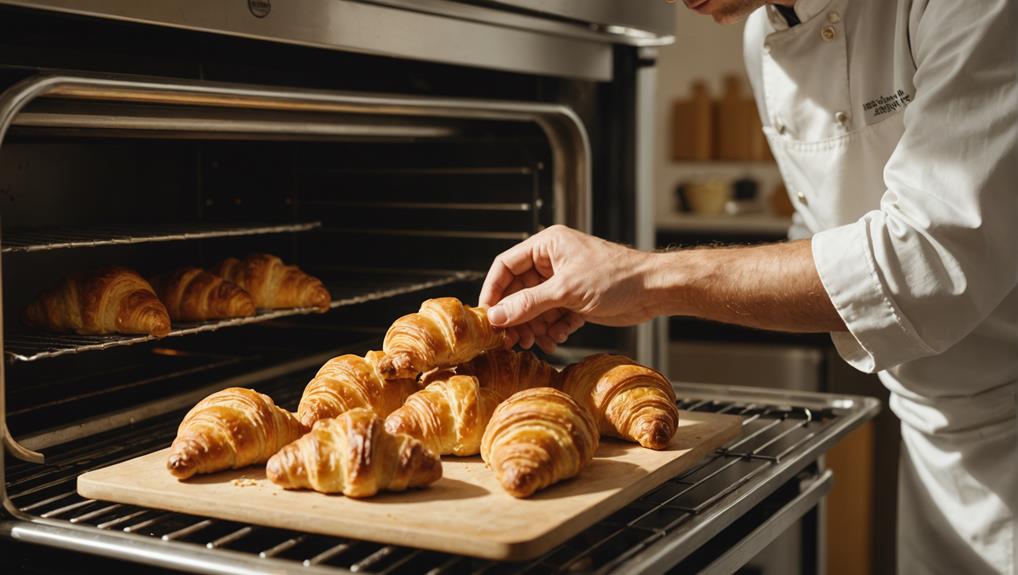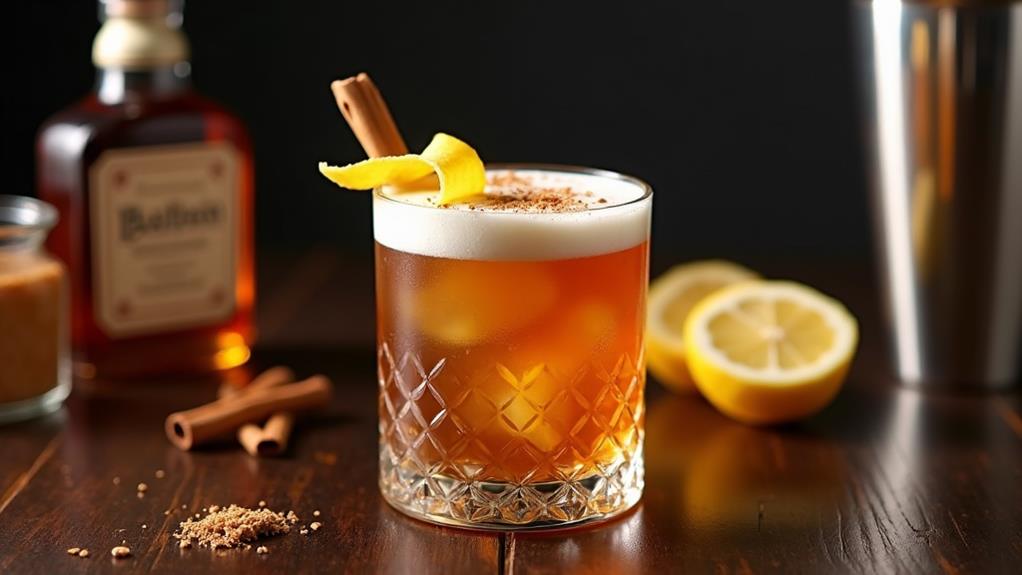Indulge your sweet tooth with gluten-free pastry perfection using these expert tips. Start by mastering flour blends, combining 40% whole grains and 60% starches. Incorporate binding agents like psyllium husk or flax seeds to mimic gluten's structure. Achieve a perfect rise by using high-protein flours and allowing batter to rest. Control temperature carefully, keeping butter cold and maintaining consistent oven heat. Mix ingredients gently to avoid dense textures, and use non-stick paper when rolling dough. Troubleshoot common issues by adjusting xanthan gum levels or blind baking to prevent soggy bases. With these techniques, you'll be well on your way to creating delectable gluten-free pastries.
Mastering Gluten-Free Flour Blends
When it comes to mastering gluten-free pastry, understanding flour blends is crucial.
To achieve the perfect balance in your gluten-free baking, you'll need to experiment with different ingredients. A successful blend typically consists of 40% whole grains and 60% starches, replicating the texture and elasticity of wheat flour.
Combine rice flour, tapioca flour, potato starch, and xanthan gum to create a high-quality mix that enhances binding and helps add moisture to your pastries.
Binding Without Eggs
When baking gluten-free pastries without eggs, you'll find that flax and chia seeds can be your secret weapons.
By mixing ground flaxseed or chia seeds with water, you'll create a gel-like consistency that mimics the binding properties of eggs.
For an extra boost of structure, consider incorporating psyllium husk powder, which not only binds ingredients but also helps prevent your pastries from crumbling.
Flax and Chia Seeds
For those seeking egg-free alternatives in gluten-free baking, flax and chia seeds offer excellent binding solutions. These tiny powerhouses act as effective egg substitutes, enhancing your gluten-free baked goods with improved texture and moisture.
To harness their binding prowess, simply mix one tablespoon of ground flaxseed or chia seeds with 2.5 tablespoons of water. Let this mixture sit for 5-10 minutes until it forms a gel-like consistency, mimicking the properties of eggs in traditional baking.
Not only do flax and chia seeds serve as binding agents, but they also boost the nutritional profile of your treats. Rich in fiber and omega-3 fatty acids, these seeds contribute to a healthier pastry experience.
When incorporating them into vegan recipes, you'll find that they maintain structure without compromising taste. For optimal results, grind whole flax seeds to ensure better nutrient absorption and binding properties.
Chia seeds, on the other hand, can be used whole or ground depending on your desired texture. By mastering the use of flax and chia seeds, you'll unlock a world of innovative, gluten-free baking possibilities.
Psyllium Husk Magic
A secret weapon in gluten-free baking, psyllium husk powder offers a remarkable solution for binding without eggs. This innovative ingredient acts as a powerful binding agent, mimicking the structure typically provided by gluten. You'll want to use about one tablespoon per cup of gluten-free flour in your recipes.
Psyllium husk's magic doesn't stop at binding. It's a moisture retention superhero, helping you achieve softer textures and combating the dreaded dryness often associated with gluten-free baked goods. As an added bonus, it boosts the nutritional profile of your pastries by contributing approximately 4 grams of dietary fiber per tablespoon.
When incorporating psyllium husk into your gluten-free recipes, remember to combine it with sufficient liquid. This crucial step allows it to absorb water and swell, forming a cohesive dough that's easier to work with.
For those exploring vegan baking or egg-free adaptations, psyllium husk shines as a versatile alternative in recipes traditionally relying on eggs for binding. Embrace this gluten-free baking tip, and you'll be well on your way to creating delectable pastries that rival their gluten-containing counterparts.
Achieving Perfect Rise

How can you achieve that elusive perfect rise in gluten-free pastries? The key lies in mastering a few innovative techniques. Start by incorporating leavening agents like baking powder or baking soda into your gluten-free flour mix. These powerhouse ingredients create air pockets, resulting in a lighter texture.
Experiment with high-protein gluten-free flours such as almond or chickpea to enhance structure and promote better rise. Give your batter time to rest before baking. Allow at least 30 minutes for hydration, activating the leavening agents and improving overall texture. This crucial step can make a significant difference in your gluten-free treats.
When it's time to bake, preheat your oven to 180°C (350°F) for consistent heat distribution. Monitor baking time closely, as gluten-free pastries tend to brown faster. Look for golden edges as a visual cue of readiness without sacrificing rise.
Mixing for Optimal Texture
When mixing gluten-free pastry ingredients, you'll want to achieve thorough incorporation without overdoing it.
Start by combining your dry ingredients and cold butter until you reach a breadcrumb-like consistency, which will help maintain the desired texture in your final pastry.
Remember, overmixing can lead to denser textures, so mix just until all ingredients are incorporated.
Consider allowing your batter to rest for about 30 minutes before baking to improve hydration and enhance the overall texture.
Proper Ingredient Incorporation
Proper ingredient incorporation stands out as a crucial step in achieving the perfect gluten-free pastry texture. You'll need to master the art of mixing to create a tender, flaky crust that rivals its gluten-containing counterparts.
Start by combining your gluten-free flour with xanthan gum, then cut in cold butter until you've reached a breadcrumb-like consistency. This process is key to ensuring a light, airy texture in your final product.
Next, gradually add beaten eggs to your flour mixture, mixing until a dough forms. Be careful not to overmix, as this can lead to a dense texture. Remember, gluten-free baking often requires a bit of trial and error to perfect your technique.
Once you've formed your dough, let it rest in the fridge for 30 minutes. This resting period allows the ingredients to hydrate fully, improving the overall texture and making the dough easier to handle.
When you're ready to roll out your pastry, use non-stick baking paper to maintain its shape and prevent tearing. By following these tips, you'll be well on your way to creating delicious, gluten-free pastries with the perfect texture.
Avoiding Overmixing Pitfalls
Three key factors contribute to avoiding overmixing pitfalls in gluten-free pastry: timing, technique, and texture awareness. To achieve a fluffy texture, it's crucial to mix your gluten-free batter for just 30 seconds to 1 minute. This brief mixing time ensures ingredients are combined without overworking the dough, which can lead to dense results.
When incorporating cold butter and flour, aim for a breadcrumb-like consistency. This texture indicates the mixture is ready for liquid addition without excessive mixing.
To further enhance your pastry's structure, experiment with allowing the batter to rest for 30 minutes before baking. This resting period improves flavor absorption and texture, reducing the need for prolonged mixing.
Master the gentle folding technique to combine wet and dry ingredients effectively. This method minimizes overmixing risks while ensuring even distribution of flavors and moisture.
As you work, stay attuned to your batter's texture, stopping when ingredients are just blended. By focusing on these strategies, you'll avoid common overmixing pitfalls and create gluten-free pastries with optimal texture and taste.
Temperature Control Secrets

Temperature control is the secret weapon in your gluten-free pastry arsenal. Mastering this crucial element will elevate your baking game, ensuring consistently delectable results.
Start by keeping your butter cold, as this maintains its strength and malleability, essential for achieving the perfect texture. When mixing ingredients, use a food processor but exercise caution to avoid overmixing, which can generate unwanted heat.
Chilling the dough for at least 30 minutes before rolling is a game-changer. This step solidifies the fats, preventing breakage and guaranteeing a crisp finish.
When you're ready to roll, work swiftly and employ non-stick baking paper to minimize warmth transfer from your hands. This technique prevents the dough from becoming sticky and difficult to handle.
Oven temperature control is equally vital. Monitor it closely, as gluten-free pastries tend to brown faster than their traditional counterparts. Aim for a consistent temperature of 200C/180C fan for optimal results.
Troubleshooting Gluten-Free Pastry Problems
While mastering temperature control is key, you'll inevitably face challenges when crafting gluten-free pastries.
Don't be discouraged; instead, embrace these hurdles as opportunities to experiment and innovate.
When troubleshooting common issues, consider these baking tips:
- If your pastry is too crumbly, add more binding agent like xanthan gum to improve texture.
- Combat soggy bases by blind baking with beans and brushing with egg white before adding fillings.
- Prevent shrinkage by chilling the dough longer to relax it before baking.
- Avoid tough pastry by mixing just until the dough comes together, aiming for a breadcrumb-like consistency.
- Keep your dough from breaking during rolling by using non-stick baking paper and keeping it cold.
Frequently Asked Questions
Is There a Trick to Baking With Gluten-Free Flour?
You'll master gluten-free baking by experimenting with flour types, moisture retention, and texture enhancement. Focus on binding agents, flavor boosters, and adjusting baking powder ratios. Don't forget ingredient substitutions, oven temperature tweaks, and recipe adjustments for innovative, delicious results.
How to Stop Gluten-Free Pastry From Crumbling?
To prevent crumbling, you'll need binding agents and moisture retention. Use a quality flour blend, control temperature, handle dough carefully, and balance ingredient ratios. Chill dough, consider egg substitutes, and adjust baking time for optimal texture.
How to Make Gluten-Free Baked Goods Taste Good?
By Jove! You'll elevate your gluten-free bakes by focusing on flavor enhancement, smart ingredient substitutions, and moisture retention. Experiment with sweetener choices, adjust baking times, and perfect cooling techniques. Innovative recipe experimentation and flavor pairing will revolutionize your treats' taste and texture.
Should You Let Gluten-Free Cake Batter Sit Before Baking?
You'll want to let your gluten-free cake batter sit for 30 minutes. This innovative technique improves texture, enhances flavor, and retains moisture. It's a game-changer for gluten-free substitutions, ensuring better consistency and baking results.
Final Thoughts
You've now unlocked the secrets to gluten-free pastry perfection. Armed with these tips, you'll create delectable treats that'll rival any traditional baked goods. Remember, practice makes perfect, so don't be discouraged if your first attempts aren't flawless. Like a skilled blacksmith forging a masterpiece, you'll refine your techniques over time. Keep experimenting with different flour blends, binding agents, and baking methods. Soon, you'll be crafting gluten-free pastries that'll delight even the most discerning palates.















